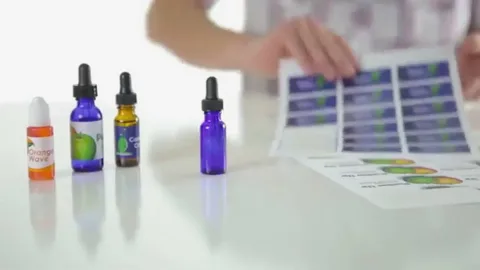In today's market, the presentation and packaging of products play a crucial role in attracting and retaining customers. One such essential aspect is the labeling of dropper bottles, widely used in industries like pharmaceuticals, cosmetics, and essential oils. This article delves into the significance, design, regulatory requirements, and best practices for creating effective dropper bottle labels.
The Importance of Dropper Bottle Labels
Dropper bottle labels serve multiple purposes:
Identification: They help in identifying the product quickly and accurately, which is vital in industries where precise dosages and usage are crucial.
Branding: Labels act as a primary branding tool, creating a first impression and fostering brand recognition.
Regulatory Compliance: Labels provide necessary information to comply with industry regulations and standards.
User Instructions: They offer essential instructions for usage, dosage, and storage, ensuring consumer safety and product efficacy.
Designing Effective Dropper Bottle Labels
Creating a compelling dropper bottle label involves a combination of aesthetic appeal and functional clarity. Here are the key elements to consider:
Brand Identity
Your label should reflect your brand’s identity. Use consistent colors, logos, and typography that align with your overall branding strategy. This not only helps in building brand recognition but also ensures that your product stands out on the shelf.
Material and Durability
Choose a label material that withstands various environmental conditions such as moisture, oil, and chemicals. Common materials include:
Paper: Suitable for dry environments and products not exposed to oils or moisture.
Vinyl: Offers durability and water resistance, making it ideal for products like essential oils.
Polyester: Known for its durability and resistance to harsh conditions, suitable for industrial applications.
Clear and Concise Information
Ensure that the label includes all necessary information in a clear and concise manner. This typically includes:
Product Name: Make it prominent and easy to read.
Ingredients: List all active ingredients, especially for pharmaceutical and cosmetic products.
Usage Instructions: Provide detailed instructions for use, dosage, and application.
Warnings: Include any safety warnings or precautions.
Expiration Date: Clearly indicate the product's expiration date to ensure user safety.
Legibility
The text on the label should be legible. Use font sizes and styles that are easy to read, and ensure sufficient contrast between the text and background.
Regulatory Requirements
Compliance with regulatory standards is paramount in labeling, especially for products in the pharmaceutical, cosmetic, and food industries. Here are some general guidelines:
FDA Requirements (USA)
For products sold in the United States, the Food and Drug Administration (FDA) has specific labeling requirements:
Pharmaceuticals: Labels must include the drug's name, strength, dosage form, route of administration, and a complete list of active and inactive ingredients.
Cosmetics: Labels should list ingredients in descending order of predominance and include any warnings or precautionary statements.
Food Products: Nutritional information, ingredient lists, and allergen declarations are required.
EU Regulations
In the European Union, labeling is governed by regulations such as the Cosmetic Regulation (EC) No 1223/2009 for cosmetic products and Regulation (EU) No 1169/2011 for food products. Key requirements include:
Ingredient Listing: All ingredients must be listed in descending order of weight.
Safety Information: Necessary warnings and safety precautions must be clearly indicated.
Language: Labels must be in the official language(s) of the country where the product is sold.
Other International Standards
Different countries have their own specific regulations. It is crucial to research and comply with the labeling standards in each market where your product will be sold.
Best Practices for Dropper Bottle Labeling
To create dropper bottle packaging that are not only compliant but also effective in marketing and usability, consider these best practices:
Use High-Quality Printing
Invest in high-quality printing to ensure that your labels are sharp, clear, and professional-looking. This includes using high-resolution images and text.
Incorporate Barcodes and QR Codes
Barcodes and QR codes can enhance the functionality of your labels. They provide a quick and easy way for consumers to access additional product information, verify authenticity, and track the product through the supply chain.
Tamper-Evident Features
Incorporate tamper-evident features to enhance product safety and consumer trust. This can include seals, perforations, or shrink bands that indicate if the product has been opened or tampered with.
Eco-Friendly Options
Consider using eco-friendly materials and printing processes. Sustainable packaging is becoming increasingly important to consumers and can enhance your brand’s reputation.
Consistent Branding Across Product Lines
Maintain consistent branding across all your product lines. This includes using the same logo, color schemes, and design elements. Consistency helps in building a cohesive brand identity and makes your products easily recognizable.
Case Studies
Essential Oils Industry
In the essential oils market, dropper bottle labels must convey purity and natural ingredients. Companies like doTERRA and Young Living use clean, minimalist designs with clear ingredient lists and usage instructions. Their labels often feature natural colors and imagery that reflect the purity and natural origins of the oils.
Pharmaceutical Industry
Pharmaceutical labels are heavily regulated and require precise information. Companies like Pfizer and GlaxoSmithKline ensure their labels include all necessary drug information, dosage instructions, and safety warnings. They use clear fonts and standardized formats to ensure legibility and compliance.
Cosmetic Industry
Cosmetic brands like The Ordinary and Kiehl’s focus on transparent ingredient lists and benefits. Their labels are designed to be both informative and aesthetically pleasing, often featuring modern, sleek designs that appeal to their target demographics.
Conclusion
Effective dropper bottle labeling is a critical aspect of product packaging that serves multiple functions, from ensuring regulatory compliance to enhancing brand identity and providing essential product information. By focusing on high-quality design, clear and concise information, and adherence to regulatory standards, companies can create labels that not only meet legal requirements but also attract and retain customers.
Investing in the right materials, printing processes, and design elements can significantly impact the success of your product in the market. Whether you're in the pharmaceutical, cosmetic, or essential oils industry, following the best practices outlined in this guide will help you create effective and compliant dropper bottle labels.



